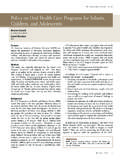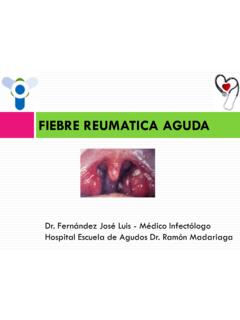Transcription of Guideline on Use of Antibiotic Therapy for Pediatric ...
1 AMERICAN ACADEMY OF Pediatric DENTISTRY. Guideline on Use of Antibiotic Therapy for Pediatric Dental Patients Originating Council Council on Clinical Affairs Review Council Council on Clinical Affairs Adopted 2001. Revised 2005, 2009, 2014. Purpose Recommendations The American Academy of Pediatric Dentistry (AAPD) recog- Conservative use of antibiotics is indicated to minimize the nizes the increasing prevalence of Antibiotic -resistant micro- risk of developing resistance to current Antibiotic regimens. 2,3. organisms. This Guideline is intended to provide guidance in Practitioners should adhere to the following general principles the proper and judicious use of Antibiotic Therapy in the when prescribing antibiotics for the Pediatric population. treatment of oral Oral wound management Methods Factors related to host risk (eg, age, systemic illness, malnutri- This Guideline is an update of the previous document adopted tion) and type of wound (eg, laceration, puncture) must be in 2001 and last revised in 2009.
2 The revision was based evaluated when determining the risk for infection and subse- upon a new systematic literature search of the PubMed electronic database using the following parameters: Terms: quent need for antibiotics. Wounds can be classified as clean, potentially contaminated, or contaminated/dirty. Facial Antibiotic Therapy , antibacterial agents, antimicrobial agents, lacerations may require topical Antibiotic agents. 4 Intraoral dental trauma, oral wound management, orofacial infections, lacerations that appear to have been contaminated by extrinsic periodontal disease, viral disease, and oral contraception; bacteria, open fractures, and joint injury have an increased risk Fields: all; Limits: within the last 10 years, humans, English, of infection and should be covered with If it is clinical trials, birth through age 18.
3 One hundred sixty-five determined that antibiotics would be beneficial to the healing articles matched these criteria. Papers for review were chosen process, the timing of the administration of antibiotics is from this search and from hand searching. When data did critical to supplement the natural host resistance in bacterial not appear sufficient or were inconclusive, recommendations killing. The drug should be administered as soon as possible for were based upon expert and/or consensus opinion by experi- the best result. The most effective route of drug administration enced researchers and clinicians. (intravenous vs. intramuscular vs. oral) must be considered. The clinical effectiveness of the drug must be monitored. The Background minimal duration of drug Therapy should be five days beyond Antibiotics are beneficial in patient care when prescribed and the point of substantial improvement or resolution of signs administered correctly for bacterial infections.
4 However, the and symptoms; this is usually a five- to seven-day course of widespread use of antibiotics has permitted common bacteria treatment dependent upon the specific drug In to develop resistance to drugs that once controlled light of the growing problem of drug resistance, the clinician Drug resistance is prevalent throughout the Some should consider altering or discontinuing antibiotics following microorganisms may develop resistance to a single anti- determination of either ineffectiveness or cure prior to com- microbial agent, while others develop multidrug-resistant pletion of a full course of If the infection is not respon- ,3 To diminish the rate at which resistance is increas- sive to the initial drug selection, a culture and susceptibility ing, health care providers must be prudent in the use of testing of isolates from the infective site may be indicated.
5 CLINICAL PRACTICE guidelines 289. REFERENCE MANUAL V 37 / NO 6 15 / 16. Special conditions Pediatric periodontal diseases Pulpitis/apical periodontitis/draining sinus tract/localized intra- Dental plaque-induced gingivitis does not require Antibiotic oral swelling Therapy . Pediatric patients with aggressive periodontal diseases Bacteria can gain access to the pulpal tissue through caries, may require adjunctive antimicrobial Therapy in conjunction exposed pulp or dentinal tubules, cracks into the dentin, and with localized In Pediatric periodontal diseases defective restorations. If a child presents with acute symptoms associated with systemic disease (eg, severe congenital neutro- of pulpitis, treatment (ie, pulpotomy, pulpectomy, or extraction) penia, Papillon-Lef vre syndrome, leukocyte adhesion should be rendered.)
6 Antibiotic Therapy usually is not deficiency), the immune system is unable to control the indicated if the dental infection is contained within the growth of periodontal pathogens and, in some cases, treatment pulpal tissue or the immediate surrounding tissue. In this may involve Antibiotic ,25 The use of systemic anti- case, the child will have no systemic signs of an infection biotics has been recommended as adjunctive treatment to (ie, no fever and no facial swelling).9,10 mechanical debridement in patients with aggressive perio- Consideration for use of antibiotics should be given in cases dontal ,25 In severe and refractory cases, extraction is of advanced non-odontogenic bacterial infections such as ,25 Culture and susceptibility testing of isolates from staphylococcal mucositis, tuberculosis, gonococcal stomatitis, the involved sites are helpful in guiding the drug ,25.
7 And oral syphilis. If suspected, it is best to refer patients for culture, biopsy, or other laboratory tests for documentation Viral diseases and definitive treatment. Conditions of viral origin such as acute primary herpetic gin- givostomatitis should not be treated with Antibiotic Therapy Acute facial swelling of dental origin unless there is strong evidence to indicate that a secondary A child presenting with a facial swelling or facial cellulitis sec- bacterial infection ondary to an odontogenic infection should receive prompt dental attention. In most situations, immediate surgical inter- Salivary gland infections vention is appropriate and contributes to a more rapid Many salivary gland infections, following confirmation of The clinician should consider age, the ability to obtain adequate bacterial etiology, will respond favorable to Antibiotic Therapy .
8 Anesthesia (local vs. general), the severity of the infection, the Acute bacterial parotitis has two forms: hospital acquired and medical status, and any social issues of the ,12 Signs community Both can be treated with antibiotics. of systemic involvement (ie, fever, asymmetry, facial swelling) Hospital acquired usually requires intravenous antibiotics; oral warrant emergency treatment. Intravenous Antibiotic Therapy antibiotics are appropriate for community acquired. Chronic and/or referral for medical management may be recurrent juvenile parotitis generally occurs prior to puberty. Penicillin remains the empirical choice for odontogenic Antibiotic Therapy is recommended and has been infections; however, consideration of additional adjunctive For both acute bacterial submandibular sialadenitis and chro- antimicrobial Therapy (ie, metronidazole) can be given where nic recurrent submandibular sialadenitis, Antibiotic Therapy is there is anaerobic bacterial included as part of the Dental trauma Oral contraceptive use Systemic antibiotics have been recommended as adjunc- Whenever an Antibiotic is prescribed to a female patient tive Therapy for avulsed permanent incisors with an open or taking oral contraceptives to prevent pregnancy, the patient closed Tetracycline (doxycycline twice daily for seven must be advised to use additional techniques of birth control days)
9 Is the drug of choice, but consideration of the child's during Antibiotic Therapy and for at least one week beyond the age must be exercised in the systemic use of tetracycline due last dose, as the Antibiotic may render the oral contraceptive to the risk of discoloration in the developing permanent ,29 Rifampicin has been documented to decrease ,14 Penicillin V or amoxicillin can be given as an the effectiveness of oral ,29 Other antibiotics, ,15,17 The use of topical antibiotics to induce pulpal particularly tetracycline and penicillin derivatives, have been revascularization in immature non-vital traumatized teeth shown to cause significant decrease in the plasma concentra- has shown some ,15,17,18 However, further random- tions of ethinyl estradiol, causing ovulation in some individuals ized clinical trials are For luxation injuries in the taking oral contraceptives.
10 28,29 Caution is advised with the primary dentition, antibiotics generally are not ,23 concomitant use of antibiotics and oral ,29. Antibiotics can be warranted in cases of concomitant soft tissue injuries (see Oral wound management) and when dictated by the patient's medical status. 290 CLINICAL PRAC TICE guidelines . AMERICAN ACADEMY OF Pediatric DENTISTRY. References 14. Andreasen JO, Andreasen FM. Avulsions. In: Textbook 1. Wilson W, Taubert KA, Gevitz M, et al. Prevention of in- and Color Atlas of Traumatic Injuries to the Teeth, 4th fective endocarditis: guidelines from the American Heart ed. Copenhagen, Denmark: Blackwell Munksgaard; 2007: Association A Guideline From the American Heart As- 461, 478-88. sociation Rheumatic Fever, Endocarditis and Kawasaki 15.










